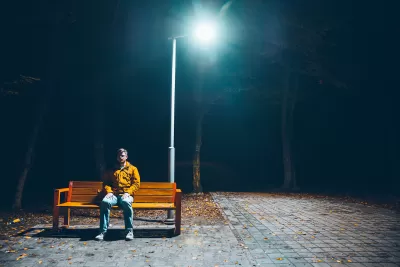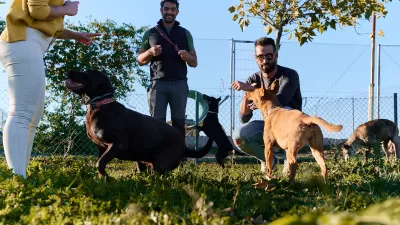Some theorists want to design cities to reduce loneliness and isolation. Others want to accommodate them.

Despite renewed attention due in part to the Surgeon General’s announcement that the nation faces a ‘loneliness epidemic,’ Alan Ehrenhalt, in a piece for Governing, notes that loneliness has been a perennial concern in American society since at least the early 20th century.
However, “Important societal changes pointing toward isolation have gathered steam in the past few decades.”
What does this have to do with urban planning? For some theorists, urban design and how we treat public space can have a significant impact on social interaction. For example, “Over the years, our parks have accumulated quite a few anti-social pieces of infrastructure: They have built unnecessary fences, placed spikes on sittable ledges and taken out benches instead of making them more inviting. Reversing those sorts of decisions would be a decent start.” Public and quasi-public ‘third spaces’ also foster social connections and offer places for people to rest and meet for free.
Others, like architecture critic Tom Brennecke, believe that cities should accommodate loneliness rather than change it. According to Brennecke, “many lonely people seem to seek social withdrawal and may, paradoxically, also benefit from being by themselves. … Public spaces should be designed to invite people to feel welcome coming alone.”
FULL STORY: The Long and Persistent History of Loneliness in America

Manufactured Crisis: Losing the Nation’s Largest Source of Unsubsidized Affordable Housing
Manufactured housing communities have long been an affordable housing option for millions of people living in the U.S., but that affordability is disappearing rapidly. How did we get here?

Americans May Be Stuck — But Why?
Americans are moving a lot less than they once did, and that is a problem. While Yoni Applebaum, in his highly-publicized article Stuck, gets the reasons badly wrong, it's still important to ask: why are we moving so much less than before?

Using Old Oil and Gas Wells for Green Energy Storage
Penn State researchers have found that repurposing abandoned oil and gas wells for geothermal-assisted compressed-air energy storage can boost efficiency, reduce environmental risks, and support clean energy and job transitions.

Minneapolis Bans Rent-Setting Software
Four cities have enacted restrictions on algorithmic software that can inflate rent costs.

Oakland to Add 244 New EV Chargers
Oakland plans to launch its new charging network at eight locations by the end of 2025.

Jane Goodall Inspires with Message of Hope, Resilience, and Environmental Action
Speaking in Pasadena, Jane Goodall offered a hopeful and inspirational message, urging global compassion, environmental responsibility, and the power of individual action to shape a better future.
Urban Design for Planners 1: Software Tools
This six-course series explores essential urban design concepts using open source software and equips planners with the tools they need to participate fully in the urban design process.
Planning for Universal Design
Learn the tools for implementing Universal Design in planning regulations.
Heyer Gruel & Associates PA
City of Moreno Valley
Institute for Housing and Urban Development Studies (IHS)
City of Grandview
Harvard GSD Executive Education
Salt Lake City
NYU Wagner Graduate School of Public Service
City of Cambridge, Maryland





























